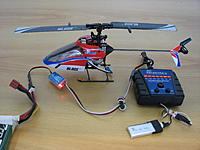Comments (4)
Add Comment
-
 Views: 322
Views: 322
Flexible strip with 144 adressable RGB LEDs (NeoPixel) per meter. -
 Views: 498
Views: 498
Arduino pro mini. One servo plug goes to the receiver (throttle channel & ground), another goes to the led strip (ground, 5v and signal pin), and the red jst connector is for power (4S). Note that the +5v is not connected to the receiver (separate pow -
 Views: 477
Views: 477
Bottom side: a small mini-360 switching regulator provides +5v to the arduino and to the leds (from a 2S-5S Lipo) -
 Views: 439
Views: 439
-
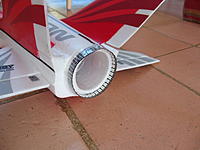 Views: 453
Views: 453
NeoPixel led strip on an FMS Super Scorpion 70mm EDF. Fixed with hot glue and tape -
 Views: 418
Views: 418
Low throttle -
 Views: 398
Views: 398
-
 Views: 380
Views: 380
-
![Name: IMG_20160313_231024234[1].jpg
Views: 220
Size: 386.3 KB
Description: Build in progress... Name: IMG_20160313_231024234[1].jpg
Views: 220
Size: 386.3 KB
Description: Build in progress...](https://static.rcgroups.net/forums/attachments/3/5/8/8/7/8/t9440021-180-thumb-IMG_20160313_231024234%5B1%5D.jpg?d=1476647845) Views: 220
Views: 220
Build in progress... -
![Name: IMG_20160314_080345741[1].jpg
Views: 207
Size: 447.8 KB
Description: The motor wires are soldered directly to the ESC Name: IMG_20160314_080345741[1].jpg
Views: 207
Size: 447.8 KB
Description: The motor wires are soldered directly to the ESC](https://static.rcgroups.net/forums/attachments/3/5/8/8/7/8/t9440020-184-thumb-IMG_20160314_080345741%5B1%5D.jpg?d=1476647787) Views: 207
Views: 207
The motor wires are soldered directly to the ESC -
![Name: IMG_20160315_080517558_HDR[1].jpg
Views: 215
Size: 347.2 KB
Description: First connection between the RX (D4R-II) and the flight controller Name: IMG_20160315_080517558_HDR[1].jpg
Views: 215
Size: 347.2 KB
Description: First connection between the RX (D4R-II) and the flight controller](https://static.rcgroups.net/forums/attachments/3/5/8/8/7/8/t9440022-148-thumb-IMG_20160315_080517558_HDR%5B1%5D.jpg?d=1476647886) Views: 215
Views: 215
First connection between the RX (D4R-II) and the flight controller -
![Name: IMG_20160506_222320276[1].jpg
Views: 207
Size: 420.2 KB
Description: Camera mount from Aomway (+ a bit of foam). Name: IMG_20160506_222320276[1].jpg
Views: 207
Size: 420.2 KB
Description: Camera mount from Aomway (+ a bit of foam).](https://static.rcgroups.net/forums/attachments/3/5/8/8/7/8/t9440032-182-thumb-IMG_20160506_222320276%5B1%5D.jpg?d=1476647968) Views: 207
Views: 207
Camera mount from Aomway (+ a bit of foam). -
![Name: IMG_20160330_110114318[1].jpg
Views: 218
Size: 282.5 KB
Description: With this "muff", the antenna is tightly maintained through some existing hole in the upper plate of the frame. This protects the transmitter in case of crashes. Name: IMG_20160330_110114318[1].jpg
Views: 218
Size: 282.5 KB
Description: With this "muff", the antenna is tightly maintained through some existing hole in the upper plate of the frame. This protects the transmitter in case of crashes.](https://static.rcgroups.net/forums/attachments/3/5/8/8/7/8/t9440130-166-thumb-IMG_20160330_110114318%5B1%5D.jpg?d=1476649966) Views: 218
Views: 218
With this "muff", the antenna is tightly maintained through some existing hole in the upper plate of the frame. This protects the transmitter in case of crashes. -
![Name: IMG_20161016_120332180[1].jpg
Views: 195
Size: 325.3 KB
Description: Name: IMG_20161016_120332180[1].jpg
Views: 195
Size: 325.3 KB
Description:](https://static.rcgroups.net/forums/attachments/3/5/8/8/7/8/t9440056-234-thumb-IMG_20161016_120332180%5B1%5D.jpg?d=1476648311) Views: 195
Views: 195
-
![Name: IMG_20161016_120430918[1].jpg
Views: 217
Size: 431.7 KB
Description: What cannot be seen (inside black shrink tubes): the OSD, some low-pass LC filter (to clean the power line feeding the camera and the vtx), and the switching regulator (->5v). Name: IMG_20161016_120430918[1].jpg
Views: 217
Size: 431.7 KB
Description: What cannot be seen (inside black shrink tubes): the OSD, some low-pass LC filter (to clean the power line feeding the camera and the vtx), and the switching regulator (->5v).](https://static.rcgroups.net/forums/attachments/3/5/8/8/7/8/t9440086-180-thumb-IMG_20161016_120430918%5B1%5D.jpg?d=1476648449) Views: 217
Views: 217
What cannot be seen (inside black shrink tubes): the OSD, some low-pass LC filter (to clean the power line feeding the camera and the vtx), and the switching regulator (->5v). -
![Name: IMG_20160823_191652896[1].jpg
Views: 211
Size: 733.2 KB
Description: A picture just for the landscape in the background... Name: IMG_20160823_191652896[1].jpg
Views: 211
Size: 733.2 KB
Description: A picture just for the landscape in the background...](https://static.rcgroups.net/forums/attachments/3/5/8/8/7/8/t9440050-168-thumb-IMG_20160823_191652896%5B1%5D.jpg?d=1476648212) Views: 211
Views: 211
A picture just for the landscape in the background...
-
Views: 310
-
Views: 296
The black lines are carbon strips. Painting not finished yet... -
Views: 298
The winglets are removable (nylon screws) -
Views: 490
Graupner CAM folding prop, and aluminum blade holder (from Aeronaut) -
Views: 292
Flight controller from RCTimer, a copy of the APM 2.5. -
Views: 310
The cover over the flight controller is made from a piece of plastic bottle. It is hold by 4 nylon screws (+bolt) glued in the EPP. -
Views: 300
Home-made aluminiuum motor mount (bullet proof!) -
 Views: 295
Views: 295
With FPV equipment. MinimOSD under the red cover (with the DR4-II).
-
 Views: 1057
Views: 1057
-
Views: 717
LCD I2C Display. Only 4 wires are needed for the connection to the Arduino. -
Views: 720
MMA7361 breakout -
Views: 901
MMA7361 breakout. The "GS" pin is connected t the ground in order to select the +/-1.5g mode of the chip. -
Views: 775
The sensor is taped on one arm (bottom left). -
 Views: 1013
Views: 1013
Schematics
-
 Views: 418
Views: 418
The VTX antenna needs to be bent downward... -
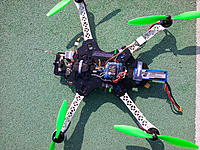 Views: 423
Views: 423
To have the CG at the right place I need to put the LiPo very much at the back... I am planning to use a slightly bigger lipo instead. -
 Views: 419
Views: 419
-
 Views: 372
Views: 372
Sunnysky x2212 - 980kv. GemFan plastic propellers (balanced with some piece of tape). -
 Views: 342
Views: 342
This mount (hobbyking) was used to fix the keychain camera (reduces the jello vdery much) and the flight controller (much better alt-hold). I replaced the stock balls by light ones (50g, also from HK). -
 Views: 414
Views: 414
The PIDS are relatively close to their default values. They are probably not yet optimal, and I will update this picture if I can improve something.
-
 Views: 598
Views: 598
The yellow cable is connected to the RX pin of the FrSky receiver and goes to the Arduino (on other side of the frame). The white wire goes to "AD2", and monitors the LiPo voltage. -
 Views: 657
Views: 657
Arduino pro mini and Hall sensor just below to the autorotation gear. A resistor (10 kOhms) to pull up the sensor output is soldered directly on the arduino board. The arduino still has to be shrink-tubed... -
 Views: 659
Views: 659
Sensor CA glued to the frame. This should be sufficiently rigid to prevent the sensor from touching the gear in case of strong vibrations. The small neodymium magnet (N35) is visible in the gear. -
 Views: 591
Views: 591
FLD-02 display: elapsed time, 3S lipo & BEC voltages. Here I was doing a test to transmit a temperature (Arduino chip internal one), but I removed it from the code provided here. -
 Views: 542
Views: 542
RPM ! Quite low since here I am just rotating the blades by hand while taking the picture ! I have tested it around 3000rpm in flight, but it should be able to measure head speed way above this anyway.
-
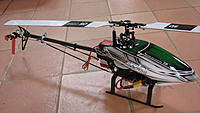 Views: 367
Views: 367
-
 Views: 652
Views: 652
Gyro: TGZ 380, very similar to the BeastX v3. -
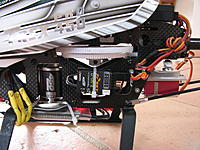 Views: 486
Views: 486
Just one signal wire (PPM sum) goes from the receiver (FrSky D4R-II) to the gyro. -
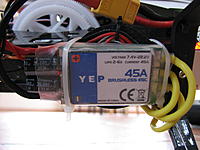 Views: 513
Views: 513
45A is a bit overkill, I think that the 40A model would be enough. -
 Views: 407
Views: 407
-
 Views: 409
Views: 409
Oups... the tail servo wire is a bit too long !
-
 Views: 1307
Views: 1307
Removing a dead Max7456 chip with a hobby knife -
 Views: 1308
Views: 1308
Max chip removed. Still need to remove the "legs" left on the board, using a (small) soldering iron. -
 Views: 1632
Views: 1632
Solder the new chip. No special tool needed, except for a fine soldering tip and a magnifying glass. Just press the leads on the soldering pads. I did not have to add any solder. -
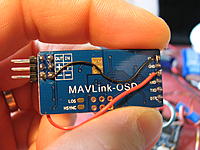 Views: 1729
Views: 1729
I do not want to fry a 3rd one... so I connected the digital & video power rails direclty on the board. My minimOSD board (clone sold by Goodluckbuy) has no solder pad to connect the power lines. So I just put two pieces of wire instead. -
 Views: 1251
Views: 1251
OSD repaired ! Just need to put the correct character set (with the OSD config tool)
-
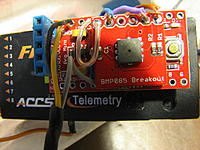 Views: 1338
Views: 1338
From front to back: BMP085 pressure sensor breakout, Arduino Pro Mini, and D8R-II Receiver. The blue connector is used to upload the firmware to the arduino using an FTDI adapter (there is no USB connection on this small Arduino board). -
 Views: 1169
Views: 1169
The data go to the receiver through the "RX" pin of the D8R-II. -
 Views: 3363
Views: 3363
Standard I2C connection (SDA & SCL) between the BMP085 board and the arduino.
-
 Views: 465
Views: 465
The GPS is not visible here, it is inside the fuse and slightly behind the motor pod. There is also an Frsky antenna running along the tail. This is to limit interferences with the FPV video TX (900Mhz) which is going to be in the cockpit. -
 Views: 460
Views: 460
The balance plug of the lipo (Nano-tech 3S 1800mAh) goes to a voltage divider, and then to the analog input of the FrSky receiver (telemetry). The ESC is a Turnigy Plush 40A (a bit over-sized for this plane/prop/motor combo). -
 Views: 489
Views: 489
The crius board is just fixed with some piece of velcro. A big cap. filters the 5v power rail. The 3A/5v BEC of the ESC powers the Crius board (+receiver & 4 servos)











 I am going to change the colors a little bit in the code,...
I am going to change the colors a little bit in the code,...



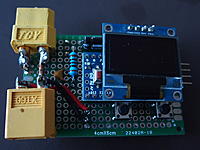





 . So far, in the setup/menus, I could not see any difference with the beastX v3.
. So far, in the setup/menus, I could not see any difference with the beastX v3.
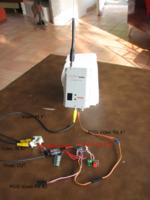




 . With some wind blowing at 10-20km/h the loiter trajectory was not quite a circle, but ok. Otherwise the plane was stable and ArduplaneNG nicely managed the throttle to maintain the speed and altitude.
. With some wind blowing at 10-20km/h the loiter trajectory was not quite a circle, but ok. Otherwise the plane was stable and ArduplaneNG nicely managed the throttle to maintain the speed and altitude.